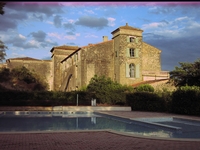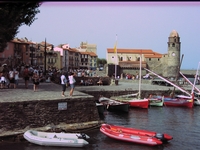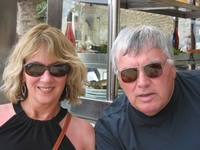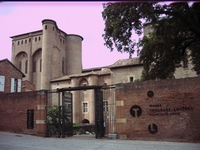 ALZONNE, France — The final leg of my summer’s journey through the wine world takes me to a renovated farming estate in the south of France, about 10 miles from the medieval city of Carcassonne.
ALZONNE, France — The final leg of my summer’s journey through the wine world takes me to a renovated farming estate in the south of France, about 10 miles from the medieval city of Carcassonne.
This is the often-overlooked wine region of Languedoc-Roussillon, where quality has been on the rise over the past 15 years while prices continue to lag behind the more coveted wines of Bordeaux, Burgundy and the Rhone Valley. It is also the land of cassoulet, Cathar ruins, medieval castles, sunny Mediterranean beaches and the picturesque Pyrenees.
I arrived by car after a four-hour drive from San Sebastian, the seaside resort along the north coast of Spain. As I took the Autoroute from the Atlantic Ocean to the Mediterranean, I sped past turnoffs for Bordeaux and Gascony to the north and the ski resorts of the Pyrenees to the south.
 My final destination, just outside the tiny village of Alzonne and close to the slightly larger village of Bram, is located in the Cabardes zone. This is the best area of the Languedoc for the Bordeaux grape varieties of cabernet sauvignon and merlot because of the Atlantic influence, which delivers cool evening breezes that help preserve acidity and freshness.
My final destination, just outside the tiny village of Alzonne and close to the slightly larger village of Bram, is located in the Cabardes zone. This is the best area of the Languedoc for the Bordeaux grape varieties of cabernet sauvignon and merlot because of the Atlantic influence, which delivers cool evening breezes that help preserve acidity and freshness.
Vineyards east of the Cabardes zone are strongly influenced by the Mediterranean, with its searing daytime temperatures and warm evenings. The Rhone grape varieties do best under those conditions, and thus are the core grapes of the Languedoc-Roussillon. Prominent appellations for this style of wine include Minervois, Saint-Chinian, Coteaux du Languedoc, Cotes du Roussillon and Corbieres.
The reds are sturdy, the whites round and generous. Though syrah is a component in many of the Languedoc-Roussillon reds, the region’s strong suit is Carignan, Grenache and Mourvedre from 60- to-100 year old vines. The sumptuous whites rely upon Grenache blanc, Marsanne, Roussanne, and small amounts of Vermentino and viognier, with a smattering of other indigenous varieties.
When visiting it is wise to stick with the AOC (Appellation d’Origine Controlee) wines, though occasionally a Vin de Pays (table wine from a non-delineated region) will stand out. The Languedoc-Roussillon region is the largest wine-growing region in the world and has underperformed for most of its history. But that dynamic is changing, making it all the more compelling for the wine lover with a thirst for discovery.
 The other allure of this wine region is the history of the area. The villages near Carcassonne were once part of the sphere of influence of the Cathars, a heretical Christian sect whose fortress ruins dot the landscape. Carcassonne itself was an important fortress city for the Romans, and once withstood a long siege by Charlemagne.
The other allure of this wine region is the history of the area. The villages near Carcassonne were once part of the sphere of influence of the Cathars, a heretical Christian sect whose fortress ruins dot the landscape. Carcassonne itself was an important fortress city for the Romans, and once withstood a long siege by Charlemagne.
Albi, at the northern edge of the Languedoc, is the birthplace of Henri Toulouse-Lautrec and home of the Toulouse-Lautrec museum, adjacent to the enormous Cathedrale Ste. Cecile, which had been built as a show of dominance by the Catholic Church during its showdown with the Cathars.
In the southwest corner of the Languedoc, less than an hour from my base, there is Limoux, where it is said the process for producing sparkling wine was discovered. Some locals even claim that Dom Perignon learned the secret of the bubbly while resting at the Abbaye de Saint-Hilaire in the midst of his pilgrimage to Spain’s Santiago de Compostela.
They say Dom Perignon took the process back to northern France and, voila, Champagne was born!
 Limoux, like Cabardes, benefits from a slightly cooler climate. It sits in the foothills of the Pyrenees and is also on the edge of the Mediterranean and Atlantic influences.
Limoux, like Cabardes, benefits from a slightly cooler climate. It sits in the foothills of the Pyrenees and is also on the edge of the Mediterranean and Atlantic influences.
The cool nights are perfect for the white grapes (chardonnay and chenin) of the Blanquette de Limoux. What is little known outside the region is that Limoux also produces the finest chardonnay as a varietals table wine in the entire Languedoc-Roussillon.
The region’s other white table wine of note is the Picpoul de Pinet, a light, un-oaked and refreshing white that is delicious with the shellfish of the Mediterranean. I emphasize table wine, because the area is quite well known for the sweet muscats of Frontignan, too.
The Languedoc-Roussillon wine region extends from Nimes and Montpellier in the east, westward and south around the curve of the Mediterranean nearly to the border with Spain. This is where the lovely whites of Collioure and the delicious dessert reds of Banyuls are made.
The seaside village of Collioure is particularly inviting, and students of art history will recognize numerous scenes made famous by Henri Matisse and Andre Derain. And the many outdoor cafes overlooking the stunning cove of Collioure will soothe even the most discriminating palate.
8
